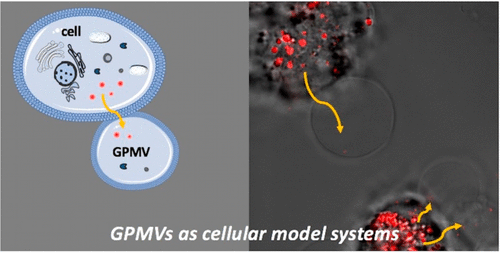当前位置:
X-MOL 学术
›
Biomacromolecules
›
论文详情
Our official English website, www.x-mol.net, welcomes your feedback! (Note: you will need to create a separate account there.)
How Can Giant Plasma Membrane Vesicles Serve as a Cellular Model for Controlled Transfer of Nanoparticles?
Biomacromolecules ( IF 5.5 ) Pub Date : 2020-07-10 , DOI: 10.1021/acs.biomac.0c00624 Luisa Zartner 1 , Martina Garni 1 , Ioana Craciun 1 , Tomaž Einfalt 2 , Cornelia G Palivan 1
Biomacromolecules ( IF 5.5 ) Pub Date : 2020-07-10 , DOI: 10.1021/acs.biomac.0c00624 Luisa Zartner 1 , Martina Garni 1 , Ioana Craciun 1 , Tomaž Einfalt 2 , Cornelia G Palivan 1
Affiliation

|
Cellular model systems are essential platforms used across multiple research fields for exploring the fundaments of biology and biochemistry. Here, we present giant plasma membrane vesicles (GPMVs) as a platform of cell-like compartments that will facilitate the study of particles within a biorelevant environment and promote their further development. We studied how cellularly taken up nanoparticles (NPs) can be transferred into formed GPMVs and which are the molecular factors that play a role in successful transfer (size, concentration, and surface charge along with 3 different cell lines: HepG2, HeLa, and Caco-2). We observed that polystyrene (PS) carboxylated NPs with a size of 40 and 100 nm were successfully and efficiently transferred to GPMVs derived from all cell lines. We then investigated the distribution of NPs inside formed GPMVs and established the average number of NPs/GPMVs and the percentage of all GPMVs with NPs in their cavity. We pave the way for GPMV usage as superior cell-like mimics in medically relevant applications.
中文翻译:

巨型血浆膜囊泡如何作为细胞模型控制纳米颗粒的转移?
细胞模型系统是跨多个研究领域探索生物学和生物化学基础的重要平台。在这里,我们提出巨质膜囊泡(GPMVs)作为细胞状隔室的平台,这将有助于研究生物相关环境中的颗粒并促进其进一步发展。我们研究了如何将细胞吸收的纳米颗粒(NP)转移到形成的GPMV中,并且分子因子与3种不同的细胞系(HepG2,HeLa和Caco)一起成功转移(大小,浓度和表面电荷) -2)。我们观察到大小为40和100 nm的聚苯乙烯(PS)羧化的NP被成功,有效地转移到派生自所有细胞系的GPMV。然后,我们调查了形成的GPMV中NP的分布,并确定了NP / GPMV的平均数量,以及所有在其腔中带有NP的GPMV的百分比。我们为GPMV的使用铺平了道路,将其用作医学相关应用中的出色细胞样模拟物。
更新日期:2020-07-10
中文翻译:

巨型血浆膜囊泡如何作为细胞模型控制纳米颗粒的转移?
细胞模型系统是跨多个研究领域探索生物学和生物化学基础的重要平台。在这里,我们提出巨质膜囊泡(GPMVs)作为细胞状隔室的平台,这将有助于研究生物相关环境中的颗粒并促进其进一步发展。我们研究了如何将细胞吸收的纳米颗粒(NP)转移到形成的GPMV中,并且分子因子与3种不同的细胞系(HepG2,HeLa和Caco)一起成功转移(大小,浓度和表面电荷) -2)。我们观察到大小为40和100 nm的聚苯乙烯(PS)羧化的NP被成功,有效地转移到派生自所有细胞系的GPMV。然后,我们调查了形成的GPMV中NP的分布,并确定了NP / GPMV的平均数量,以及所有在其腔中带有NP的GPMV的百分比。我们为GPMV的使用铺平了道路,将其用作医学相关应用中的出色细胞样模拟物。





































 京公网安备 11010802027423号
京公网安备 11010802027423号